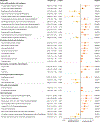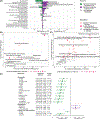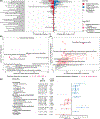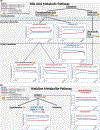Immunomodulatory metabolites in IgE-mediated food allergy and oral immunotherapy outcomes based on metabolomic profiling
- PMID: 39530396
- PMCID: PMC11756372
- DOI: 10.1111/pai.14267
Immunomodulatory metabolites in IgE-mediated food allergy and oral immunotherapy outcomes based on metabolomic profiling
Abstract
Background: The immunometabolic mechanisms underlying variable responses to oral immunotherapy (OIT) in patients with IgE-mediated food allergy are unknown.
Objective: To identify novel pathways associated with tolerance in food allergy, we used metabolomic profiling to find pathways important for food allergy in multiethnic cohorts and responses to OIT.
Methods: Untargeted plasma metabolomics data were generated from the VDAART healthy infant cohort (N = 384), a Costa Rican cohort of children with asthma (N = 1040), and a peanut OIT trial (N = 20) evaluating sustained unresponsiveness (SU, protection that lasts after therapy) versus transient desensitization (TD, protection that ends immediately afterward). Generalized linear regression modeling and pathway enrichment analysis identified metabolites associated with food allergy and OIT outcomes.
Results: Compared with unaffected children, those with food allergy were more likely to have metabolomic profiles with altered histidines and increased bile acids. Eicosanoids (e.g., arachidonic acid derivatives) (q = 2.4 × 10-20) and linoleic acid derivatives (q = 3.8 × 10-5) pathways decreased over time on OIT. Comparing SU versus TD revealed differing concentrations of bile acids (q = 4.1 × 10-8), eicosanoids (q = 7.9 × 10-7), and histidine pathways (q = .015). In particular, the bile acid lithocholate (4.97 [1.93, 16.14], p = .0027), the eicosanoid leukotriene B4 (3.21 [1.38, 8.38], p = .01), and the histidine metabolite urocanic acid (22.13 [3.98, 194.67], p = .0015) were higher in SU.
Conclusions: We observed distinct profiles of bile acids, histidines, and eicosanoids that vary among patients with food allergy, over time on OIT and between SU and TD. Participants with SU had higher levels of metabolites such as lithocholate and urocanic acid, which have immunomodulatory roles in key T-cell subsets, suggesting potential mechanisms of tolerance in immunotherapy.
Keywords: IgE‐mediated food allergy; OIT; arachidonic acid; bile acids; desensitization; eicosanoids; food allergy; histidines; immunotherapy; lithocholate; lithocholic acid; metabolomics; oral immunotherapy; peanut allergy; remission; secondary bile acids; sustained unresponsiveness; transient desensitization; urocanate; urocanic acid.
© 2024 European Academy of Allergy and Clinical Immunology and John Wiley & Sons Ltd.
Conflict of interest statement
CONFLICT OF INTEREST STATEMENT
JLS is a scientific consultant to Precion Inc. and TruDiagnostic Inc. AAL contributes to UpToDate, Inc.—author of online education, royalties totaling not more than $3000 per year. STW receives royalties from UpToDate and is on the board of Histolix a digital pathology company. JCC has received research materials (inhaled steroids) from Merck, in order to provide medications free of cost to participants in an NIH-funded study, unrelated to the current work. The remaining authors have no conflicts of interest to disclose.
Figures






Update of
-
Metabolomics of IgE-Mediated Food Allergy and Oral Immunotherapy Outcomes based on Metabolomic Profiling.medRxiv [Preprint]. 2024 Jun 1:2024.05.31.24308233. doi: 10.1101/2024.05.31.24308233. medRxiv. 2024. Update in: Pediatr Allergy Immunol. 2024 Nov;35(11):e14267. doi: 10.1111/pai.14267. PMID: 38952781 Free PMC article. Updated. Preprint.
References
MeSH terms
Substances
Grants and funding
- P30 DK040561/DK/NIDDK NIH HHS/United States
- T32 AI007062/AI/NIAID NIH HHS/United States
- U01 AI160082/AI/NIAID NIH HHS/United States
- U19 AI168643/AI/NIAID NIH HHS/United States
- AAAAI Foundation
- R01 AI155630/AI/NIAID NIH HHS/United States
- P42 ES027704/ES/NIEHS NIH HHS/United States
- UM1 AI173380/AI/NIAID NIH HHS/United States
- U01 HL091528/HL/NHLBI NIH HHS/United States
- RM1 GM145416/GM/NIGMS NIH HHS/United States
- R01 AI147028/AI/NIAID NIH HHS/United States
- R01 HL091528/HL/NHLBI NIH HHS/United States
- R01 HL123915/HL/NHLBI NIH HHS/United States
- U19 AI136053/AI/NIAID NIH HHS/United States
- R01 HL155742/HL/NHLBI NIH HHS/United States
- National Institute of Allergy and Infectious Diseases
- U54 TR001012/TR/NCATS NIH HHS/United States
- R01 HL141826/HL/NHLBI NIH HHS/United States
- K23 AI130408/AI/NIAID NIH HHS/United States
- R37 HL066289/HL/NHLBI NIH HHS/United States
- Hjärt-Lungfonden
- R01 GM141277/GM/NIGMS NIH HHS/United States
- R01 HL118455/HL/NHLBI NIH HHS/United States
- R01 HL066289/HL/NHLBI NIH HHS/United States
- UL1 TR000170/TR/NCATS NIH HHS/United States
- UL1 TR001102/TR/NCATS NIH HHS/United States
- Harvard Catalyst
- UL1 RR025758/RR/NCRR NIH HHS/United States
- UH3 OD023268/OD/NIH HHS/United States
- K01 HL146980/HL/NHLBI NIH HHS/United States
- R01 HL123546/HL/NHLBI NIH HHS/United States
LinkOut - more resources
Full Text Sources
Medical

